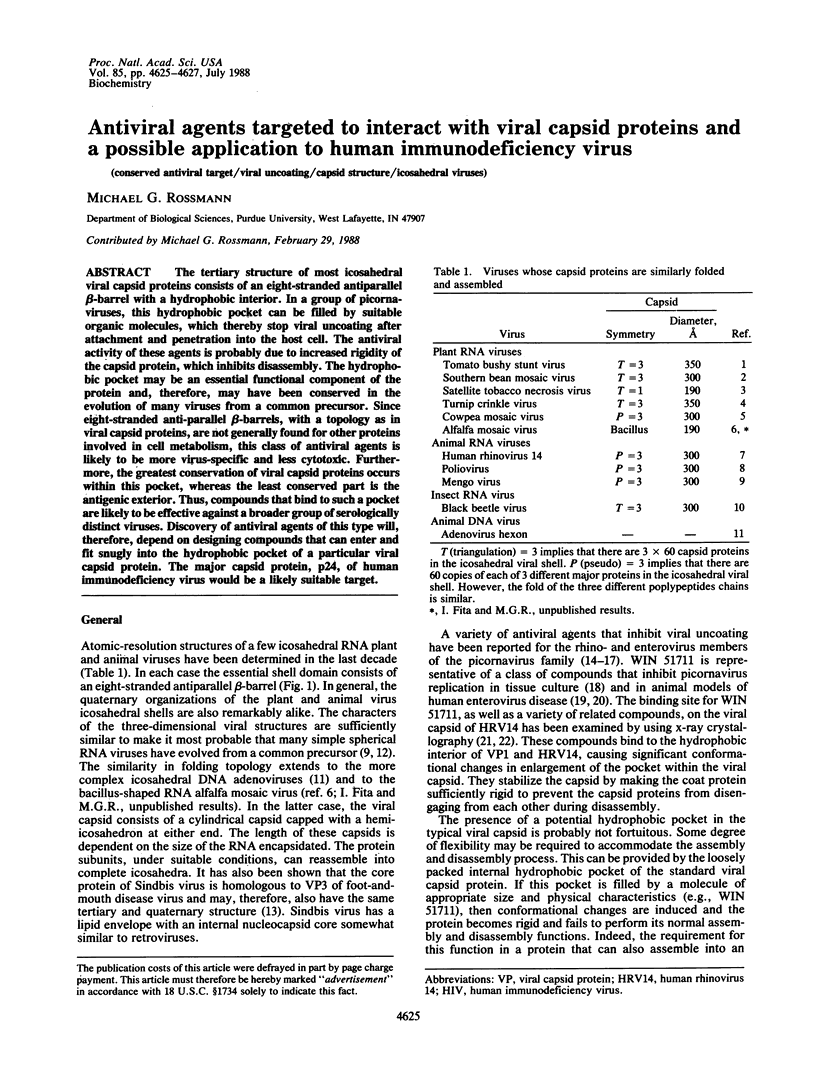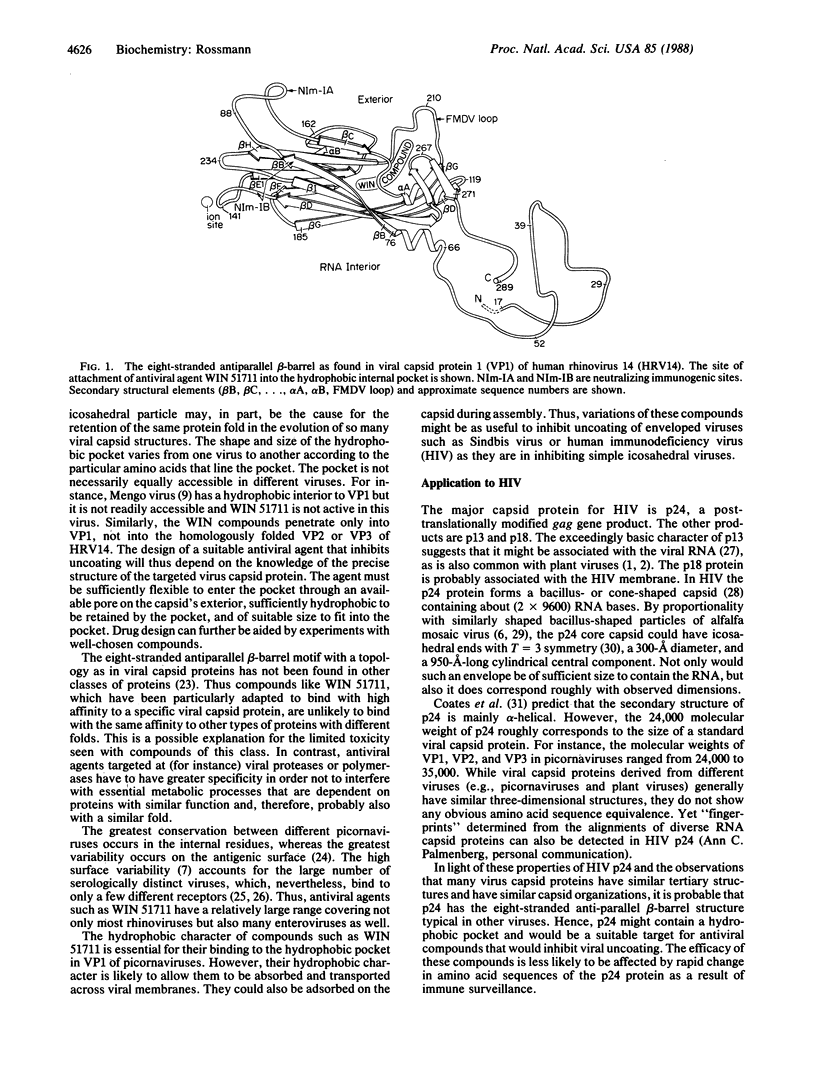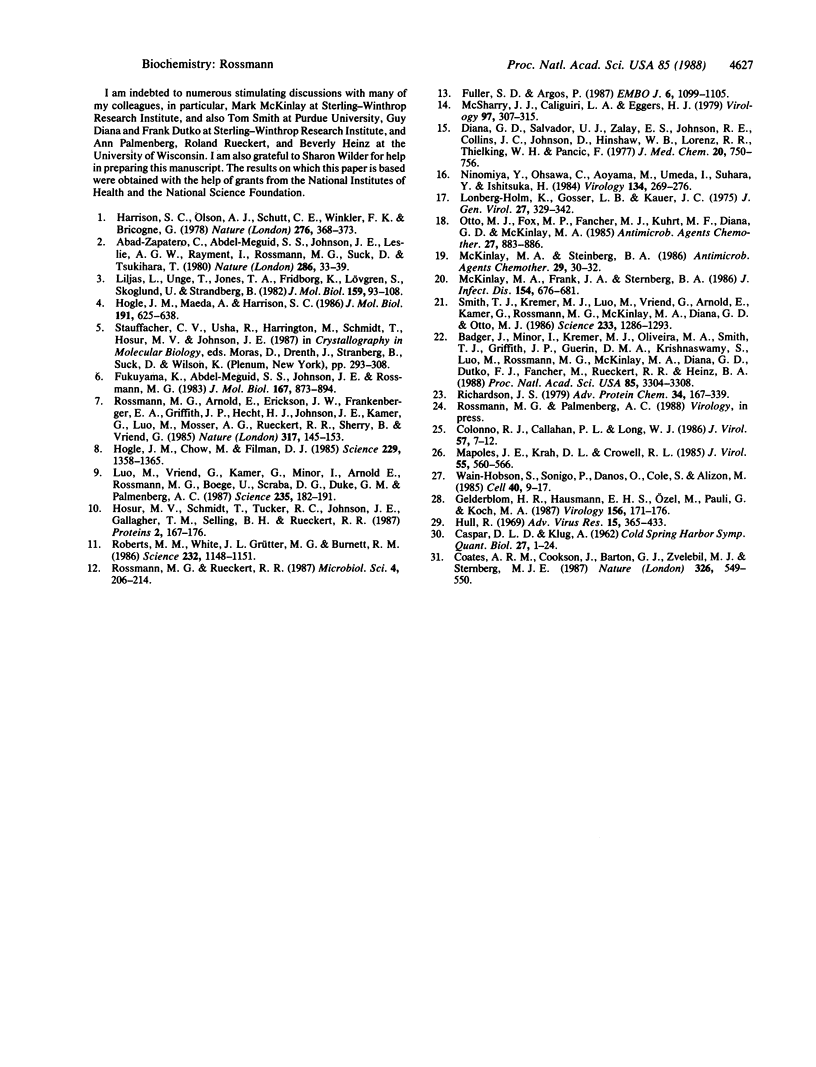Abstract
The tertiary structure of most icosahedral viral capsid proteins consists of an eight-stranded antiparallel beta-barrel with a hydrophobic interior. In a group of picornaviruses, this hydrophobic pocket can be filled by suitable organic molecules, which thereby stop viral uncoating after attachment and penetration into the host cell. The antiviral activity of these agents is probably due to increased rigidity of the capsid protein, which inhibits disassembly. The hydrophobic pocket may be an essential functional component of the protein and, therefore, may have been conserved in the evolution of many viruses from a common precursor. Since eight-stranded anti-parallel beta-barrels, with a topology as in viral capsid proteins, are not generally found for other proteins involved in cell metabolism, this class of antiviral agents is likely to be more virus-specific and less cytotoxic. Furthermore, the greatest conservation of viral capsid proteins occurs within this pocket, whereas the least conserved part is the antigenic exterior. Thus, compounds that bind to such a pocket are likely to be effective against a broader group of serologically distinct viruses. Discovery of antiviral agents of this type will, therefore, depend on designing compounds that can enter and fit snugly into the hydrophobic pocket of a particular viral capsid protein. The major capsid protein, p24, of human immunodeficiency virus would be a likely suitable target.
Full text
PDF


Selected References
These references are in PubMed. This may not be the complete list of references from this article.
- Badger J., Minor I., Kremer M. J., Oliveira M. A., Smith T. J., Griffith J. P., Guerin D. M., Krishnaswamy S., Luo M., Rossmann M. G. Structural analysis of a series of antiviral agents complexed with human rhinovirus 14. Proc Natl Acad Sci U S A. 1988 May;85(10):3304–3308. doi: 10.1073/pnas.85.10.3304. [DOI] [PMC free article] [PubMed] [Google Scholar]
- CASPAR D. L., KLUG A. Physical principles in the construction of regular viruses. Cold Spring Harb Symp Quant Biol. 1962;27:1–24. doi: 10.1101/sqb.1962.027.001.005. [DOI] [PubMed] [Google Scholar]
- Coates A. R., Cookson J., Barton G. J., Zvelebil M. J., Sternberg M. J. AIDS vaccine predictions. Nature. 1987 Apr 9;326(6113):549–550. doi: 10.1038/326549c0. [DOI] [PubMed] [Google Scholar]
- Colonno R. J., Callahan P. L., Long W. J. Isolation of a monoclonal antibody that blocks attachment of the major group of human rhinoviruses. J Virol. 1986 Jan;57(1):7–12. doi: 10.1128/jvi.57.1.7-12.1986. [DOI] [PMC free article] [PubMed] [Google Scholar]
- Diana G. D., Salvador U. J., Zalay E. S., Johnson R. E., Collins J. C., Johnson D., Hinshaw W. B., Lorenz R. R., Thielking W. H., Pancic F. Antiviral activity of some beta-diketones. 1. Aryl alkyl diketones. In vitro activity against both RNA and DNA viruses. J Med Chem. 1977 Jun;20(6):750–756. doi: 10.1021/jm00216a003. [DOI] [PubMed] [Google Scholar]
- Fukuyama K., Abdel-Meguid S. S., Johnson J. E., Rossmann M. G. Structure of a T = 1 aggregate of alfalfa mosaic virus coat protein seen at 4.5 A resolution. J Mol Biol. 1983 Jul 15;167(4):873–890. doi: 10.1016/s0022-2836(83)80116-8. [DOI] [PubMed] [Google Scholar]
- Fuller S. D., Argos P. Is Sindbis a simple picornavirus with an envelope? EMBO J. 1987 Apr;6(4):1099–1105. doi: 10.1002/j.1460-2075.1987.tb04864.x. [DOI] [PMC free article] [PubMed] [Google Scholar]
- Gelderblom H. R., Hausmann E. H., Ozel M., Pauli G., Koch M. A. Fine structure of human immunodeficiency virus (HIV) and immunolocalization of structural proteins. Virology. 1987 Jan;156(1):171–176. doi: 10.1016/0042-6822(87)90449-1. [DOI] [PubMed] [Google Scholar]
- Hogle J. M., Chow M., Filman D. J. Three-dimensional structure of poliovirus at 2.9 A resolution. Science. 1985 Sep 27;229(4720):1358–1365. doi: 10.1126/science.2994218. [DOI] [PubMed] [Google Scholar]
- Hogle J. M., Maeda A., Harrison S. C. Structure and assembly of turnip crinkle virus. I. X-ray crystallographic structure analysis at 3.2 A resolution. J Mol Biol. 1986 Oct 20;191(4):625–638. doi: 10.1016/0022-2836(86)90450-x. [DOI] [PubMed] [Google Scholar]
- Hosur M. V., Schmidt T., Tucker R. C., Johnson J. E., Gallagher T. M., Selling B. H., Rueckert R. R. Structure of an insect virus at 3.0 A resolution. Proteins. 1987;2(3):167–176. doi: 10.1002/prot.340020302. [DOI] [PubMed] [Google Scholar]
- Hull R. Alfalfa mosaic virus. Adv Virus Res. 1969;15:365–433. doi: 10.1016/s0065-3527(08)60880-5. [DOI] [PubMed] [Google Scholar]
- Liljas L., Unge T., Jones T. A., Fridborg K., Lövgren S., Skoglund U., Strandberg B. Structure of satellite tobacco necrosis virus at 3.0 A resolution. J Mol Biol. 1982 Jul 25;159(1):93–108. doi: 10.1016/0022-2836(82)90033-x. [DOI] [PubMed] [Google Scholar]
- Lonberg-Holm K., Gosser L. B., Kauer J. C. Early alteration of poliovirus in infected cells and its specific inhibition. J Gen Virol. 1975 Jun;27(3):329–342. doi: 10.1099/0022-1317-27-3-329. [DOI] [PubMed] [Google Scholar]
- Luo M., Vriend G., Kamer G., Minor I., Arnold E., Rossmann M. G., Boege U., Scraba D. G., Duke G. M., Palmenberg A. C. The atomic structure of Mengo virus at 3.0 A resolution. Science. 1987 Jan 9;235(4785):182–191. doi: 10.1126/science.3026048. [DOI] [PubMed] [Google Scholar]
- Mapoles J. E., Krah D. L., Crowell R. L. Purification of a HeLa cell receptor protein for group B coxsackieviruses. J Virol. 1985 Sep;55(3):560–566. doi: 10.1128/jvi.55.3.560-566.1985. [DOI] [PMC free article] [PubMed] [Google Scholar]
- McKinlay M. A., Frank J. A., Jr, Benziger D. P., Steinberg B. A. Use of WIN 51711 to prevent echovirus type 9-induced paralysis in suckling mice. J Infect Dis. 1986 Oct;154(4):676–681. doi: 10.1093/infdis/154.4.676. [DOI] [PubMed] [Google Scholar]
- McKinlay M. A., Steinberg B. A. Oral efficacy of WIN 51711 in mice infected with human poliovirus. Antimicrob Agents Chemother. 1986 Jan;29(1):30–32. doi: 10.1128/aac.29.1.30. [DOI] [PMC free article] [PubMed] [Google Scholar]
- McSharry J. J., Caliguiri L. A., Eggers H. J. Inhibition of uncoating of poliovirus by arildone, a new antiviral drug. Virology. 1979 Sep;97(2):307–315. doi: 10.1016/0042-6822(79)90342-8. [DOI] [PubMed] [Google Scholar]
- Ninomiya Y., Ohsawa C., Aoyama M., Umeda I., Suhara Y., Ishitsuka H. Antivirus agent, Ro 09-0410, binds to rhinovirus specifically and stabilizes the virus conformation. Virology. 1984 Apr 30;134(2):269–276. doi: 10.1016/0042-6822(84)90296-4. [DOI] [PubMed] [Google Scholar]
- Otto M. J., Fox M. P., Fancher M. J., Kuhrt M. F., Diana G. D., McKinlay M. A. In vitro activity of WIN 51711, a new broad-spectrum antipicornavirus drug. Antimicrob Agents Chemother. 1985 Jun;27(6):883–886. doi: 10.1128/aac.27.6.883. [DOI] [PMC free article] [PubMed] [Google Scholar]
- Richardson J. S. The anatomy and taxonomy of protein structure. Adv Protein Chem. 1981;34:167–339. doi: 10.1016/s0065-3233(08)60520-3. [DOI] [PubMed] [Google Scholar]
- Roberts M. M., White J. L., Grütter M. G., Burnett R. M. Three-dimensional structure of the adenovirus major coat protein hexon. Science. 1986 May 30;232(4754):1148–1151. doi: 10.1126/science.3704642. [DOI] [PubMed] [Google Scholar]
- Rossmann M. G., Arnold E., Erickson J. W., Frankenberger E. A., Griffith J. P., Hecht H. J., Johnson J. E., Kamer G., Luo M., Mosser A. G. Structure of a human common cold virus and functional relationship to other picornaviruses. Nature. 1985 Sep 12;317(6033):145–153. doi: 10.1038/317145a0. [DOI] [PubMed] [Google Scholar]
- Rossmann M. G., Reuckert R. R. What does the molecular structure of viruses tell us about viral functions? Microbiol Sci. 1987 Jul;4(7):206–214. [PubMed] [Google Scholar]
- Smith T. J., Kremer M. J., Luo M., Vriend G., Arnold E., Kamer G., Rossmann M. G., McKinlay M. A., Diana G. D., Otto M. J. The site of attachment in human rhinovirus 14 for antiviral agents that inhibit uncoating. Science. 1986 Sep 19;233(4770):1286–1293. doi: 10.1126/science.3018924. [DOI] [PubMed] [Google Scholar]
- Wain-Hobson S., Sonigo P., Danos O., Cole S., Alizon M. Nucleotide sequence of the AIDS virus, LAV. Cell. 1985 Jan;40(1):9–17. doi: 10.1016/0092-8674(85)90303-4. [DOI] [PubMed] [Google Scholar]


